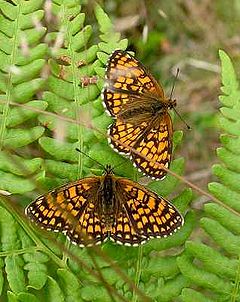Heath Fritillary
| Heath fritillary | |
|---|---|
 |
|
| Scientific classification | |
| Kingdom: | Animalia |
| Phylum: | Arthropoda |
| Class: | Insecta |
| Order: | Lepidoptera |
| Family: | Nymphalidae |
| Genus: | Melitaea |
| Species: | M. athalia |
| Binomial name | |
|
Melitaea athalia (Rottemburg, 1775) |
|
| Synonyms | |
|
Mellicta athalia |
|
Mellicta athalia
The heath fritillary (Melitaea athalia) is a butterfly of the family Nymphalidae. It is found throughout the Palaearctic from Western Europe to Japan, in heathland, grassland, and in coppiced woodland. Its association with coppiced woodland earned it the name "woodman's follower" in parts of the UK. It is considered a threatened species in the UK and Germany, but not Europe-wide or globally.
Heath fritillaries have a wingspan of 39–47 mm. The upperside is predominantly dark brown and orange-brown, with the orange-brown spots delineated by dark brown (along and across the wing-veins); there is a white fringe to the wings through which the dark brown extends. The upperside of the body is a similar dark brown to the colour on the wing, and the base of both wings is dark brown. The underside shows bands of red and (off-)white, again with each vein dark brown and each colour delineated by dark brown. The pattern of white spots at the base of the hindwing (visible at rest) is diagnostic for identification.
Male
Male underside
Female
Female underside
The heath fritillary ranges throughout the Palaearctic region from Western Europe to Japan. In Europe, it is absent from Iceland, Ireland, Scotland, Wales, southern Portugal, southern Spain, the Mediterranean islands and southern Greece.
In the UK, it is restricted to Cornwall and Devon grasslands (abandoned hay-meadows); Exmoor (heathland); and Kent and Essex (coppiced woodland on acid soils). The populations in Essex are the result of reintroductions, and further reintroductions are ongoing in various other parts of the UK. In the late 1990s, the species was estimated to occupy just 0.2% within the 10-km grid squares over the whole of its UK range.
Its altitudinal range is from sea-level to 2600 m.
Heath fritillary is not listed on the IUCN Red List, suggesting that globally it is not considered threatened. In the UK, however, the species was "considered to be the most endangered British butterfly" after a nationwide survey in 1980 found only 31 surviving colonies. Consequently, it was given protection under the Wildlife and Countryside Act 1981. Despite subsequent widespread efforts to conserve and manage the species' habitats, it has continued to decline: distribution has declined 25% since the 1970s, and abundance-wise it declined by 46% in the 10 years 1995–2004. Woodland sites in Kent and Essex are actively managed (coppiced) for the conservation of this species. It has been a "high priority" species in the UK Biodiversity Action Plan (BAP) since 1995 and has its own Species Action Plan.
...
Wikipedia
